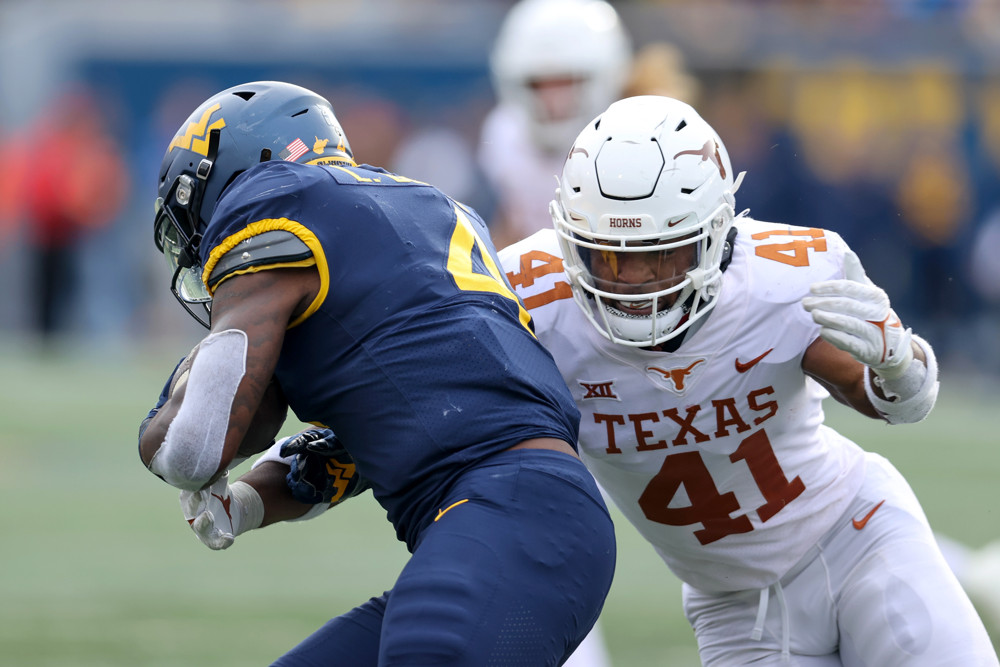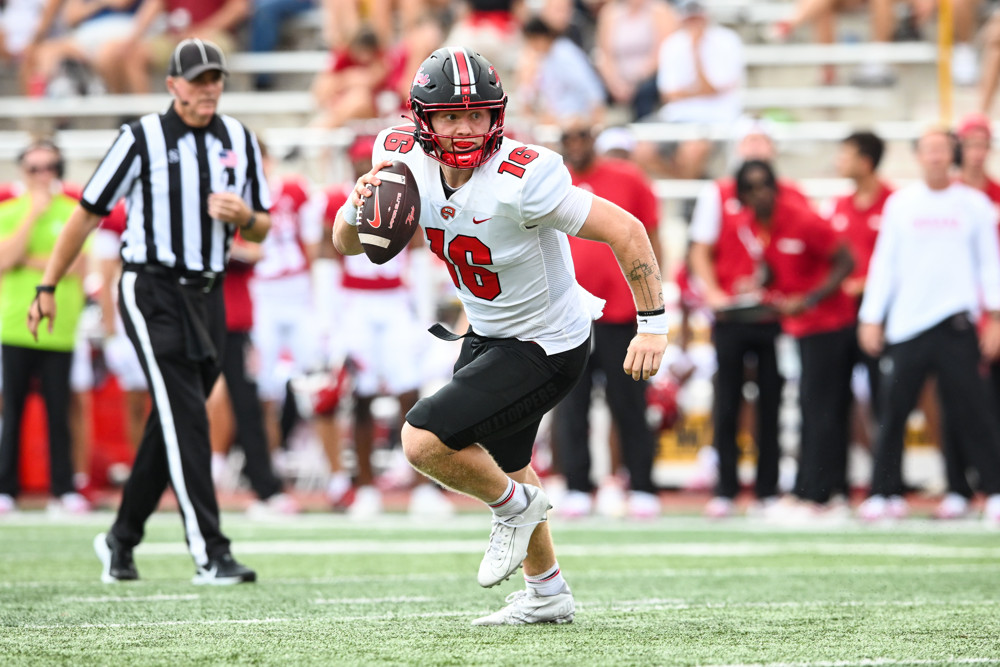Kansas football over the last decade has been, to put it mildly, less than stellar. Since the end of the 2009 season, Kansas has gone 23-118 overall and 7-99 in the Big 12. The Jayhawks had lost 56 consecutive Big 12 road games, before beating Texas this past season, and 44 consecutive games against AP-ranked teams.
During this stretch, they also set the FBS football record for most consecutive road losses with 46 until they beat Central Michigan in 2018. Lance Leipold is the sixth head coach of the program since Mark Mangiano resigned and inherited a program that hasn’t been ranked since 2009.
Leipold has his work cut out for him as Kansas struggled in just about every area in 2020 and continued to do so in 2021. The Jayhawks were outscored by almost 22 points per game in 2021.
They averaged 3.8 yards per rush while allowing 6.0. They’ve completed 61% of their passes to their opponents 70%. It’s a rough watch.
Kansas has become the laughingstock of college football and is a non-threat year in and year out.
So how does a team that has gone winless in two of the last seven seasons compete in the high-octane Big 12?
Embrace the triple option
The triple option is not a glamorous offensive scheme, but it can still be highly effective. Kansas doesn’t attract the same level of recruits as the more successful Big 12 teams so it can’t play the same game at their level. Instead, Kansas should slow the game down and run the ball in a conference historically known for poor, or at least exposed, defenses.
Let’s start with some of the triple option principles.
Triple option offenses need their linemen to get after the opposing defensive linemen, a smart quarterback who can make the correct read, and several effective running backs. The entire offense needs to be well-disciplined, but because players aren’t asked to win one-on-one battles in space often, the scheme can help eliminate some of the talent gap.
Offenses move at a slower pace in the triple option, which will allow the Kansas defense to rest more and take the ball out of the opposing quarterback’s hands. Running this scheme will result in some negative plays, but they aren’t as prevalent and are usually minor losses, putting the offense in a lot more short-yardage third-down situations.
Since 2017, triple option runs have averaged more yards per carry (5.5) than non-triple option designed runs (4.9). In addition, they have a significantly higher positive yard percentage and a significantly lower negative yard percentage.
| Triple Option Runs | Non-Triple Option Runs | |
| Positive Yardage | 87% | 80% |
| Negative Yardage | 7% | 12% |
| No gain | 6% | 8% |
Triple Option in the NCAA Today
Army, Navy, and Air Force are some of the most recognizable triple option teams in college football and have had a lot of recent success running the scheme. Army has had at least 8 wins in five of the last six years, Navy has had at least 8 wins in 15 of the last 19 years, Air Force has had a winning record in 10 of the last 15 years, and Georgia Tech in the late 90’s and early 2000s had 13 straight seasons with a winning record, running primarily the triple option.
Some of the positive effects can be clearly seen with 2021 data.
Air Force ranked 1st out of 130 FBS teams in time of possession, Army was 2nd, and Navy was 5th, while Kansas was 38th. This keeps the opposing offenses off the field and slows the game down for teams that struggle to stay with high powered offenses.
Two of the most telling stats are plays per game and opponent plays per game. Air Force, Navy, and Army were 34th, 85th, and 97th respectively in offensive plays per game while Kansas was 124th.
Army, Navy, and Air Force were 2nd, 3rd, and 4th respectively in opponent plays per game while Kansas was 43rd. When you combine those numbers, the average Air Force game and Kansas game had about the same amount of plays, but Air Force ran about 10 more offensive plays a game while their defense conversely was on the field for 10 fewer plays.
Keeping the defense fresh and establishing a running game early are major factors in a triple option offense, and over the course of a season, it adds up.
Triple Option in the Power 5
All of these stats are nice, but could it actually work in a Power 5 football conference?
Oklahoma had firsthand experience with the difficulty of a triple option team in 2018.
Oklahoma was ranked 5th in the country heading into a home game with Army. Oklahoma was favored by 28.5 points at kickoff and its fanbase was expecting an easy win. Army had other plans. Though the Sooners ended up winning the game, they needed to go to overtime to defeat the pesky Black Knights.
The reason it was so close wasn’t that Oklahoma couldn’t move the ball on offense. The opposite in fact. Oklahoma averaged nearly 9 yards per play, but Army kept the ball out of future Hesiman winner Kyler Murray’s hands.
Army had the ball for an unbelievable 45 minutes of game time. It averaged 4.3 yards per play, putting itself in a lot of 3rd-and-short situations. It converted 13-of-21 3rd-down conversions and 4-of-5 4th-down conversions. Oklahoma only had three 3rd downs all game and Army ran 87 plays to Oklahoma’s 40.
There were a total of 16 possessions, including overtime, in the game. While Army did lose, it did everything right to keep the game within reach and an extra turnover was the only real thing that kept them from winning.
Even in games where the time of possession is more balanced, triple option teams have a way of hanging around. Michigan was favored by 22.5 points against Army in Ann Arbor in 2019, but still needed double overtime to win the game.
While playing sound defense was a major part of this game, Michigan only had two tackles for loss in the game which allowed Army to have 3rd and short frequently. Even when the Army offense was struggling, they took time off the clock and shortened the game which was nearly enough to pull off the massive upset.
Kansas’ Recruiting Advantage
While the service academies may not face Power 5 opponents on a weekly basis, they have been generally effective when they do play. Army, Navy, and Air Force have had the luxury of perfecting their offense over a lengthy period of time, where Kansas would be starting from square one, so where can Kansas make up some ground?
One advantage Kansas could have against the service academies is recruiting. According to 247Sports, Kansas hasn’t finished above 8th in the Big 12 recruiting classes since 2011 and more often than not, finds itself in last. The vicious cycle is tough to break. Kansas doesn’t win so recruits don’t want to go to Kansas. Kansas doesn’t get recruits so Kansas doesn’t win. It perpetuates year in and year out. They can’t offer the national exposure or NFL development that teams like Oklahoma or Texas can offer so it’s tough to compete against those schools. It can offer a few things the service academies can’t however.
Service academies don’t award full scholarships for football, Kansas can. The requirements to get into a service academy are much higher than at Kansas. Players looking to play in a triple option offense in college will now have a more difficult choice which could steer a few talented players towards Kansas.
If recruits are motivated to play at the next level more by football than serving their country, Kansas can be an attractive alternative. Triple option offense can still be found in high school programs and giving those players a familiar offensive scheme can benefit both sides. Kansas should be able to recruit better players than Army, Navy, and Air Force giving them a chance at a high-functioning triple option team despite a lack of tradition.
The triple option is not the most exciting offense in the world. It’s an old school, lunch pail style offense, but it can give Kansas a chance to compete, something that it hasn’t done for awhile. The road back to relevance is a long and arduous one, but it is achievable. Kansas has had so little success trying the conventional ways so honestly, what does it have to lose?


